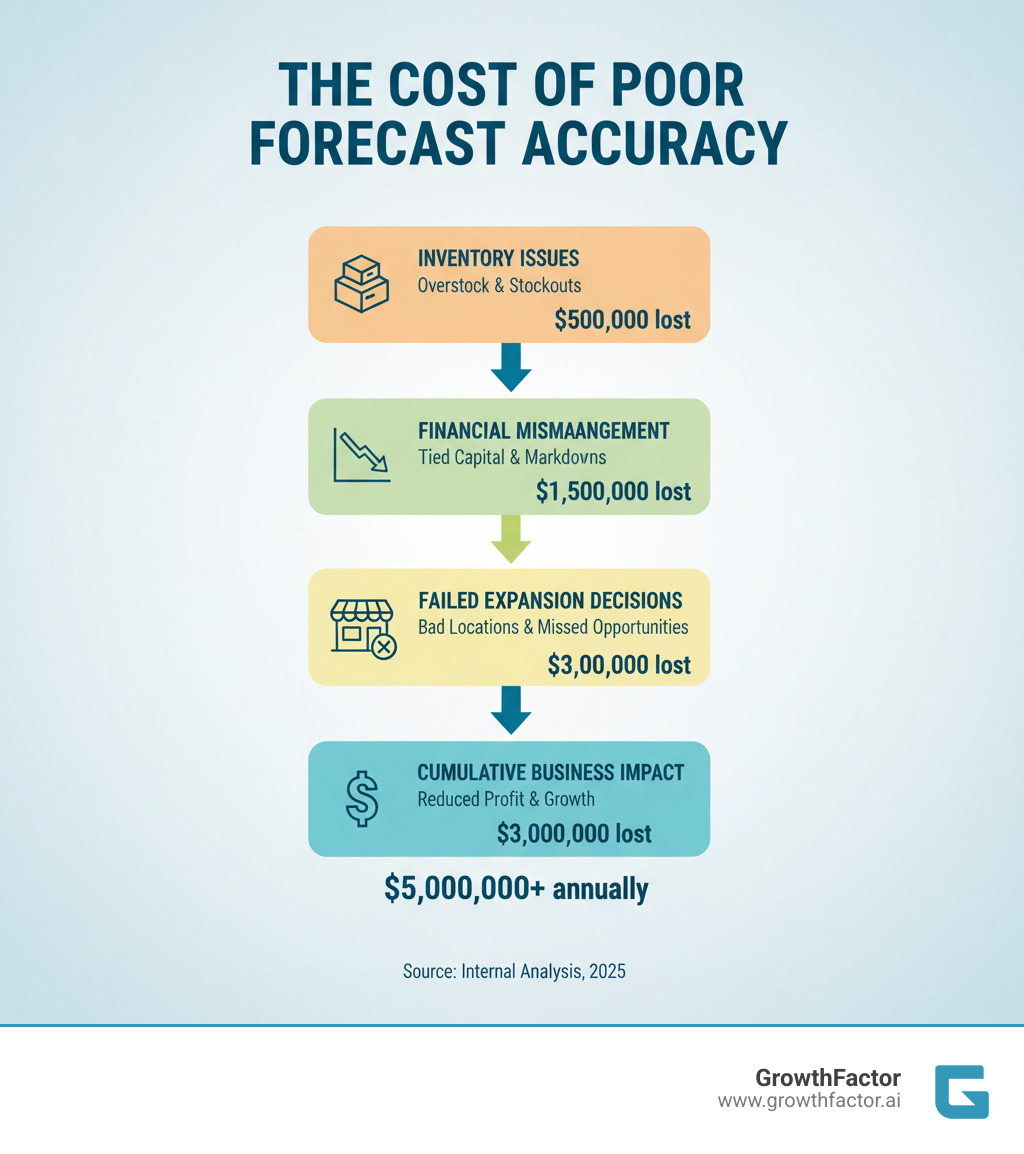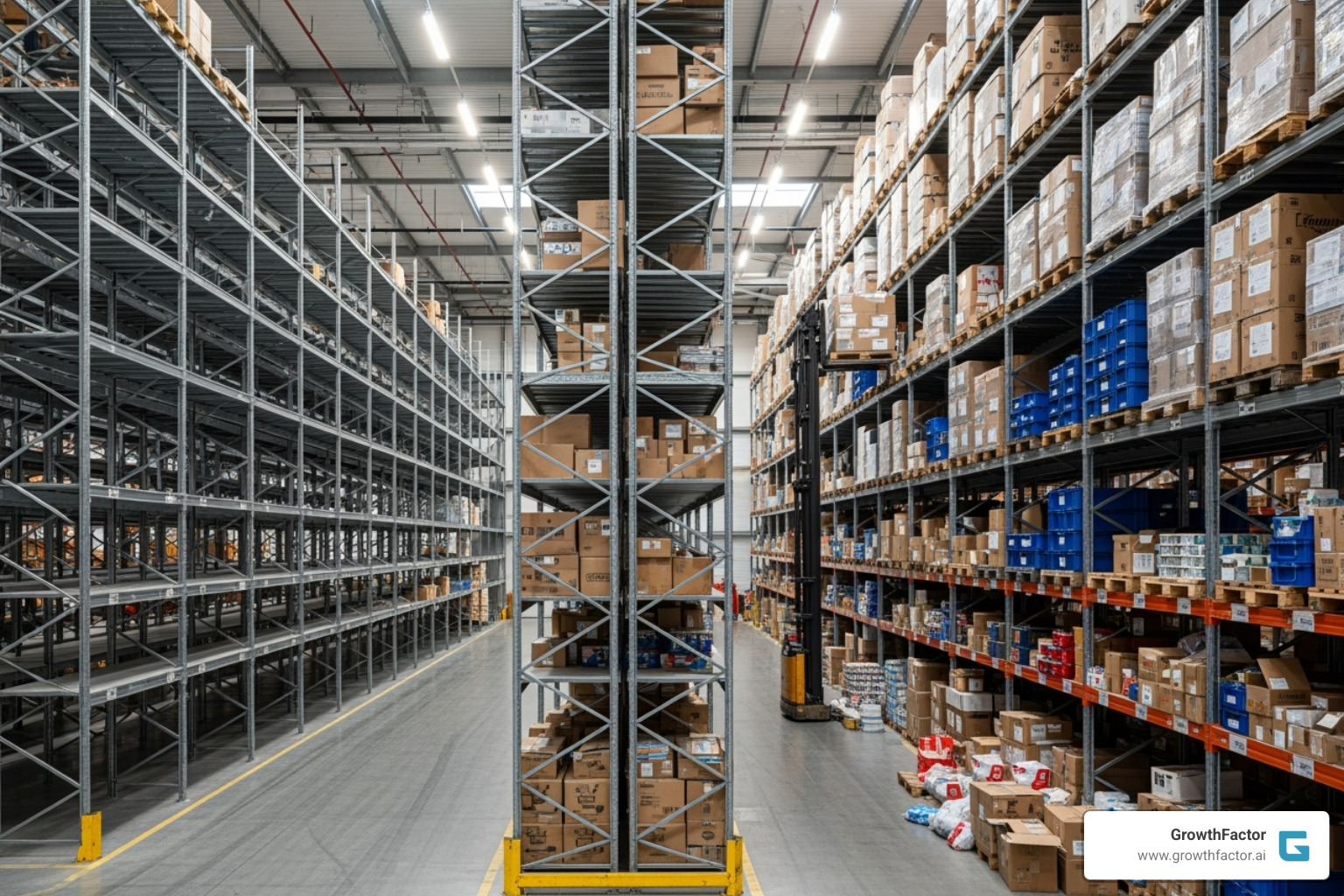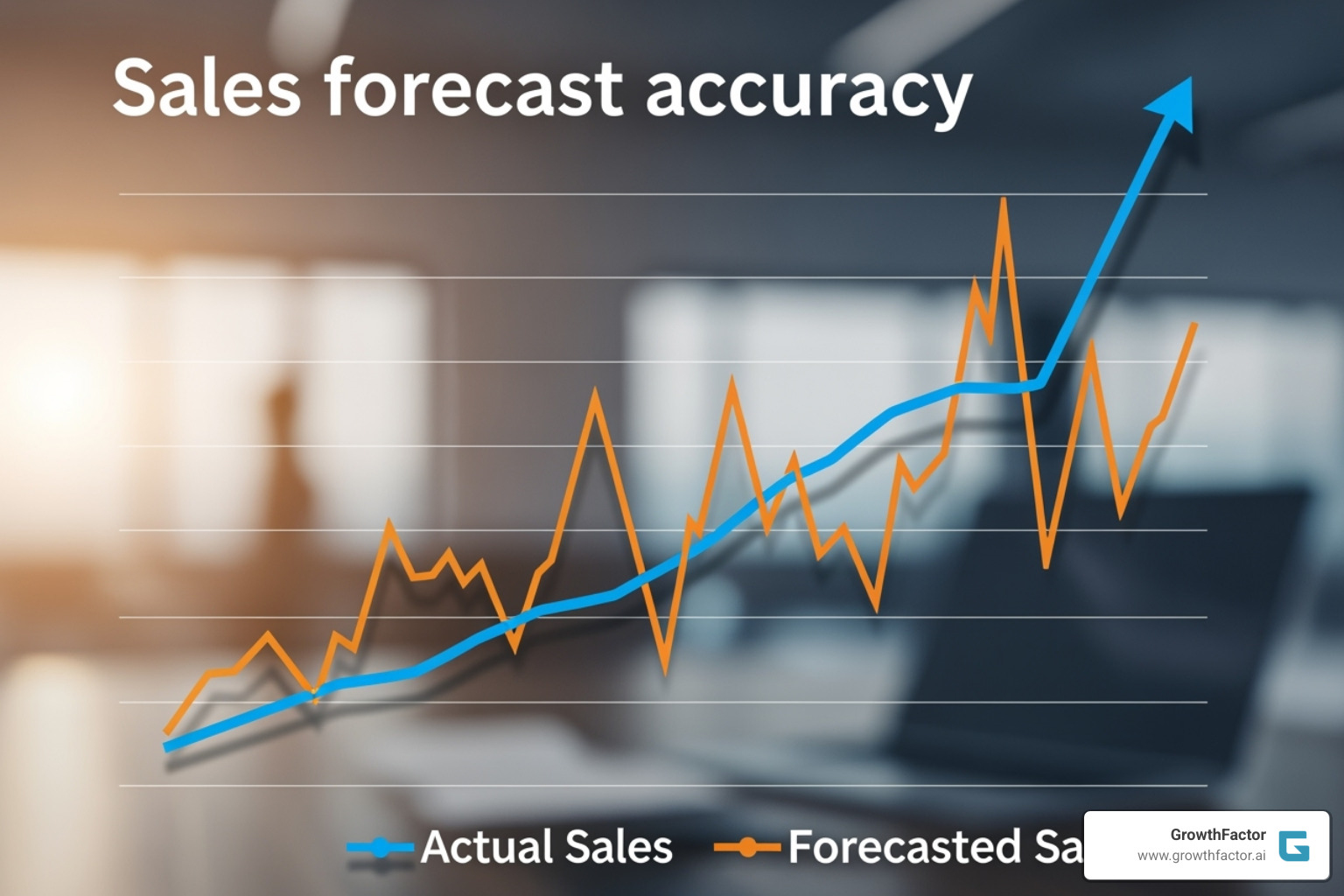Are Your Sales Forecasts 100% Accurate? Here's How to Find Out
Why Sales Forecast Accuracy Is the Foundation of Smart Retail Expansion

Sales forecast accuracy is the measure of how closely your predicted sales match actual results. For retail executives planning expansion, this metric is critical. It determines whether you'll stock the right inventory, staff locations appropriately, and make profitable site selection decisions—or waste capital on failed locations.
Key ways to measure sales forecast accuracy:
- MAPE (Mean Absolute Percentage Error) - Shows average error as a percentage, easy to understand across different product lines.
- MAE (Mean Absolute Error) - Measures average error in actual units (dollars or items), useful for comparing similar products.
- RMSE (Root Mean Squared Error) - Penalizes large errors more heavily, ideal for identifying systematic problems.
- Forecast Bias - Reveals if you consistently over-predict or under-predict, signaling process issues.
Many retailers struggle with this. Research shows that 81% of sales leaders cite disconnected data and reliance on intuition as their biggest obstacles to accurate forecasting. When revenue projections for potential store locations are off by 20%, you risk choosing the wrong sites or passing on profitable opportunities.
Inaccurate forecasts lead to:
- Overstocking that ties up capital and forces markdowns.
- Stockouts that frustrate customers and send them to competitors.
- Misjudged market potential resulting in poorly performing locations.
- Resource allocation errors across staffing, inventory, and capital.
The gap between forecast and reality costs retailers millions. Companies with accurate forecasts are significantly more likely to achieve year-over-year revenue growth. I'm Clyde Christian Anderson, and I founded GrowthFactor.ai after years in retail real estate tackling these exact challenges. I've seen how poor sales forecast accuracy derails expansion and how the right data and technology transform site selection into a competitive advantage.

Simple Sales forecast accuracy glossary:
Why Inaccurate Forecasts Are Costing Your Business
Every percentage point of forecast error translates into wasted dollars. When your sales forecast accuracy is off, you're not just dealing with incorrect numbers; you're watching money drain from your business through multiple leaks.
Impact on Inventory, Finance, and Operations
Forecasting failures have tangible consequences. In warehouses, they manifest as empty shelves where products should be (stockouts) and dusty boxes of unwanted goods (overstock).

Inventory Management: Under-forecasting leads to stockouts, lost sales, and frustrated customers who go to competitors. Over-forecasting ties up capital in unsold inventory, increases storage costs, and risks product spoilage or obsolescence. Effective sales forecast accuracy must integrate with smart Retail Demand Forecasting across the supply chain.
Financial Planning: Your sales forecast is the foundation of your financial plan. Over-optimistic forecasts lead to inflated budgets and spending you can't support. Pessimistic forecasts cause you to miss growth opportunities. Inaccurate forecasts also lead to cash flow mismanagement, with capital either locked in inventory or insufficient to cover operational needs.
Operations and Strategy: Operations teams plan staffing and production around expected demand. Inaccurate forecasts cause chaotic swings from overstaffing to understaffing, hurting both your budget and customer service. Most importantly, every major strategic decision—from product launches to market entry—relies on demand predictions. Companies with accurate forecasts are more likely to achieve revenue growth because they make better strategic calls, especially in Data-Driven Site Selection, where a single bad location can cost millions.
The Difference Between Forecast Accuracy and Forecast Bias
It's crucial to distinguish between forecast accuracy and forecast bias.
- Forecast accuracy measures the magnitude of your error—how close your predictions are to the actual results, regardless of direction.
- Forecast bias measures the direction of your error—whether you consistently overestimate or underestimate. A short article from the University of Arizona explains that a positive bias (BIAS > 0) indicates underestimation, while a negative bias (BIAS < 0) indicates overestimation.
Identifying bias is critical because it points to a systemic flaw in your process, even if your overall accuracy seems acceptable.
The Ripple Effect on Retail and Real Estate Decisions
For retailers making expansion decisions, forecast errors multiply into expensive mistakes. A 15% error in sales projections doesn't just mean 15% less revenue—it can mean choosing the wrong location entirely.
- Site selection becomes a gamble. Unreliable revenue projections lead to investing in underperforming locations or passing on high-potential sites.
- Lease negotiations are weakened. Without defensible sales forecasts, you lose leverage with landlords, resulting in unfavorable terms.
- Expansion strategies become flawed. A pattern of inaccuracy means your entire growth strategy is built on a weak foundation, allowing competitors with better sales forecast accuracy to gain an edge.
Our Site Selection Analysis Guide details how accurate forecasts, combined with location intelligence, turn high-stakes decisions into data-backed strategies.
How to Measure Sales Forecast Accuracy
Measuring sales forecast accuracy is like checking your GPS; it verifies you've reached your destination. Regular measurement transforms vague predictions into reliable business intelligence, allowing you to spot patterns, identify weaknesses, and build a data-driven culture.

The key is to maintain a forecast archive—a historical record of predictions versus actuals. This archive serves as your benchmark for refining your approach. Choosing the right metrics is also vital, as no single number tells the whole story. Select metrics that align with your strategic priorities and track them consistently.
Key Metrics for Measuring Sales Forecast Accuracy
Each of these core metrics provides a unique view of your forecast performance.
Mean Absolute Percentage Error (MAPE): Expresses the average forecast error as a percentage. Its intuitive nature makes it useful for comparing accuracy across different products or services, regardless of their scale. A 5% MAPE means forecasts are typically off by 5%.
Mean Absolute Error (MAE): Calculates the average magnitude of errors in the same units as your data (e.g., dollars or items). It provides a straightforward answer to "how far off are we, on average?" and is excellent for comparing forecasts for the same item.
Root Mean Squared Error (RMSE): This metric squares errors before averaging them, giving disproportionately high weight to large errors. Use RMSE when a single massive forecasting mistake would be catastrophic for your business, as it highlights this risk more effectively than MAE.
Forecast Bias: Reveals whether you consistently overestimate or underestimate demand by examining the direction of errors, not just their magnitude. Identifying persistent bias is crucial because it signals systemic flaws in your forecasting process that need to be addressed.
Setting Realistic Expectations and Benchmarks
What is a good level of forecast accuracy? There is no universal answer. The right target depends on several factors:
Industry and Product: A stable consumer good might achieve 95% accuracy for a monthly forecast, while a trendy fashion item forecasted six months out might be excellent at 70%.
Forecast Horizon: Short-term forecasts are almost always more accurate than long-term ones. The further you predict, the more uncertainties arise.
Market Stability: Mature, stable markets are easier to forecast than volatile, trend-driven ones.
As a general benchmark, high-performing sales organizations often target 85% forecast accuracy, with best-in-class teams achieving 90-95%. However, the primary goal should be continuous improvement against your own historical performance. A forecast that is 90% accurate at the company level but only 60% at the store level can still cause operational chaos, so measure accuracy where it truly impacts your business.
Common Pitfalls and Key Influencing Factors
Even with the right metrics, many retailers sabotage their sales forecast accuracy by falling into common traps. Understanding the factors that influence forecasts and the mistakes that derail them is essential for building a system that works.

Factors That Influence Forecast Accuracy
Multiple variables determine whether your predictions hit or miss the mark.
- Data Quality: The "garbage in, garbage out" principle is paramount. Incomplete, error-ridden, or inconsistent historical data will produce a flawed forecast. Poor data quality can cost companies 15-25% of their revenue.
- Historical Data Volume: More data leads to more reliable forecasts. A long history of detailed sales data allows for the identification of robust patterns.
- Market Volatility: Stable markets are easier to predict than trend-driven, uncertain ones. Your accuracy expectations must reflect your market's nature.
- Seasonality and Trends: Failing to account for predictable seasonal fluctuations (e.g., holidays) or long-term market shifts will throw forecasts off considerably.
- External Events: Economic shifts, competitor actions, regulatory changes, or societal disruptions can alter demand patterns overnight. Forecasting is about managing this uncertainty, not eliminating it, which is critical for Retail Demand Forecasting.
Mistakes to Avoid in Your Forecasting Process
These common mistakes are often the biggest barriers to achieving meaningful sales forecast accuracy.
- Relying on Gut Feelings: Experience is valuable, but intuition without data is wishful thinking. Salespeople are natural optimists, which can introduce a positive bias that skews predictions.
- Using Disconnected Spreadsheets: According to research, 81% of sales leaders say disconnected data is a major obstacle. Siloed spreadsheets cause version control nightmares, data integrity issues, and poor collaboration.
- Ignoring Historical Data: Past sales patterns provide crucial insights into seasonality, product lifecycles, and performance. Dismissing this data means choosing to be less informed.
- Working in Silos: Forecasting requires input from sales, marketing, finance, and operations. When these departments are not aligned, they work with conflicting numbers, leading to inefficiencies. This is especially damaging for Data-Driven Site Selection, which requires cross-functional insights.
A Framework for Improving Your Forecasts
Improving sales forecast accuracy is a continuous process, not a one-time fix. The best approach follows a Plan-Do-Check-Act (PDCA) cycle, where you constantly plan, execute, check, and adjust your forecasting methods. Real breakthroughs occur when you harmonize three key elements: people (team collaboration), process (systematic approach), and technology (enabling tools).
Best Practices for Improving Sales Forecast Accuracy
These battle-tested strategies consistently improve forecast accuracy.
- Establish a Clear Sales Process: A well-defined, consistent process ensures everyone is speaking the same language, making it easier to spot trends and discrepancies.
- Improve Data Quality and Management: Move from scattered spreadsheets to a centralized system with validation rules. Clean data is the bedrock of any accurate forecast.
- Choose the Right Forecasting Models: No single model fits all situations. Use a combination of methods and regularly evaluate if your chosen approach is still effective.
- Foster Cross-Functional Collaboration: Break down departmental silos. Joint review sessions with sales, marketing, and finance produce higher-quality forecasts.
- Establish a Continuous Feedback Loop: Regularly compare actuals to forecasts, analyze variances, and learn from mistakes. This is where real improvement happens.
- Clean Your Pipeline Regularly: Remove stale opportunities that artificially inflate your forecast. Deals with no activity for 30+ days are 80% less likely to close.
- Account for External Factors: Systematically incorporate market trends, seasonality, economic conditions, and competitive moves into your predictions.
- Align Sales and Marketing: Create unified definitions and shared metrics to build a cohesive go-to-market strategy and improve lead generation.
- Hold Regular Forecast Reviews: Implement a consistent cadence of reviews with key stakeholders to analyze performance and make adjustments.
Leveraging Data and Technology for Higher Precision
Manual forecasting with spreadsheets is no longer competitive. To achieve high sales forecast accuracy, businesses must accept modern data and technology.
The first step is moving to a centralized data system to create a single source of truth. From there, AI and machine learning can revolutionize forecasting. These technologies analyze massive datasets to identify complex patterns, sense demand shifts in real-time, and eliminate the human bias that often skews predictions.
The results are significant. Some companies have boosted forecasting accuracy from 24% to 76% using machine learning. AI tools can also provide forecast ranges with confidence levels, offering a more nuanced view of the future.
Implementing these technologies is more accessible than ever. At GrowthFactor, our AI-powered platform is designed to improve forecast accuracy for smarter site selection. We leverage these capabilities in our AI-Powered Retail Analytics and AI Location Intelligence offerings, providing clients with insights that were previously impossible to obtain.
Frequently Asked Questions about Sales Forecast Accuracy
Here are concise answers to common questions about sales forecast accuracy from retail and real estate professionals.
What is a good sales forecast accuracy rate?
There is no single universal answer. A "good" rate depends on your industry, product, and forecast horizon. A stable consumer good might achieve 95% accuracy for a monthly forecast, while 70% accuracy for a trendy item forecasted six months out could be excellent. The most important goal is continuous improvement against your own historical benchmarks.
How often should I measure forecast accuracy?
Your measurement frequency should align with your business cycle. Monthly or quarterly reviews are common and effective for most retailers. For faster-moving inventory, weekly checks may be necessary. The key is to establish a regular, consistent cadence for measuring, analyzing, and adjusting your process to create a continuous feedback loop.
Can a forecast be 100% accurate?
No, consistently achieving 100% accuracy is unrealistic. Forecasting involves predicting future events and human behavior, which are inherently uncertain. The goal is not perfection but to minimize error and understand the probability of different outcomes. A good forecast is one that is accurate enough to drive profitable operations, smart inventory planning, and confident strategic decisions.
Conclusion
The path to better sales forecast accuracy is a journey of continuous improvement, and the rewards are substantial. The first step is always measurement. Metrics like MAPE, MAE, and RMSE transform forecasting from guesswork into a manageable discipline.
From there, the goal is progress, not perfection. This means cleaning your data, fostering collaboration, and creating feedback loops to learn from your results. Today, technology has changed the game. The spreadsheet era is over; modern AI and machine learning tools can identify complex patterns, reduce bias, and deliver accuracy levels that were previously impossible, with some companies seeing improvements from 24% to 76%.
At GrowthFactor, we've built our platform on this principle. For high-stakes retail real estate decisions, forecast accuracy is the difference between expanding confidently and expanding blindly. Our AI-powered tools improve the precision of your revenue projections, enabling smarter site selection and growth planning.
Data-driven forecasting provides a clear strategic advantage, giving you the confidence to move faster and more intelligently than competitors. It turns the uncertainty of retail expansion into a calculated, manageable risk.
Ready to transform your retail expansion strategy? Explore our All-in-One Real Estate Platform for Retail and start building a more predictable, profitable future.
Citations
The human algorithm
Ready to see what we're cooking?
Submit your information below and we'll be in touch to schedule.







